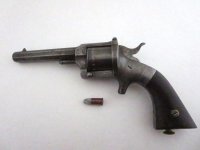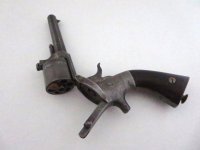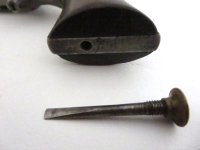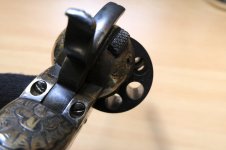bcowern
Member
While looking for info on Francis DeGress, of Wexel & Degress, patented pistol grips, I came across photo of an iron framed pistol carried by Francis DeGress, that was manufactured by Lucius W. Pond. These pistols have a connection to S&W.
This revolver is marked on the upper left barrel flat: “Manuf’d for Smith & Wesson Pat’d April 5, 1855”.

Marking on barrel flat

.44 Pond pistol in S&W case(?) 7 1/4" barrel

Pond pistol showing screwdriver that was screwed into bottom grip strap'

Pond started production of his .32 long RF Single Action Pocket or Belt revolver in 1861 ending 1870.
Pond was sued by Rollin White and S&W in 1862 and lost the lawsuit. After the lawsuit, and after adding the “Manuf’d for Smith & Wesson Pat’d April 5, 1855”. to the left barrel flat, Pond sold the remaining inventory and subsequent production to S&W for $7.80 apiece, covering manufacturing costs, little if any profit. A total of about 4500 revolvers.
S&W in turn sold the revolvers for $12 to $13 depending on barrel length of 4”, 5”, or 6”.
If these revolvers were sold by S&W, do factory records exist for them?
There is an interesting bit of history with Lucius Pond.
“As mentioned before, Lucius Pond had been promptly sued by Rollin White for violating White’s patent with the belt revolver. Pond turned over his stock of remaining belt revolvers to Smith & Wesson, and then began manufacturing the front-load revolver. Like his predecessor Samuel Flagg, Lucius Pond’s fortune started to change in the 1870s. It’s likely that the economic effects of Re- construction, and the subsequent Long Depression that started in 1873 contributed to Pond’s difficulties. Despite serving as a director of the Central National Bank, Pond found himself in dire straits. By 1874, Pond was washing bank checks and re-issuing them to himself for much larger amounts. In one instance, a $500 check was subsequently altered into an $1,100 check. Needless to say, Pond was deeply in debt.
Late in 1875, Pond’s fraud came to light and that October, Pond disappeared completely (Figure 18). He had set out from Worcester for New York City, but he quickly escaped to Hamilton, Ontario, where he found work as a machinist. But he knew that the law would catch up to him in Ontario, so he again set off for San Francisco, where he boarded a boat for faraway Australia. But for the work of Detective Ezra Churchill, Pond would very likely have disappeared down under. Pond was arrested on the boat and returned to Worcester , where he stood trial for his fraud – estimated to have exceeded $100,000. He was convicted and sentenced to 15 years in prison.
Pond – always eloquent and loquacious – remained a favorite among his friends and family. His pastor visited him in prison and commented that “I never saw a better man in the world, and I never expect to, till I am in heaven.” Pond’s friends and families petitioned the Governor of Massachusetts twice for his pardon. They were successful the second time, and Governor Long pardoned Lucius Pond in December of 1882, having served only six years of his sentence. Lucius Pond quietly lived in Worcester with his wife until he died in 1889.”
Video of the Lucius Pond revolver
[ame="https://www.youtube.com/watch?v=lpXUK9W74QY"]https://www.youtube.com/watch?v=lpXUK9W74QY[/ame]
Regards,
bcowern
This revolver is marked on the upper left barrel flat: “Manuf’d for Smith & Wesson Pat’d April 5, 1855”.

Marking on barrel flat

.44 Pond pistol in S&W case(?) 7 1/4" barrel

Pond pistol showing screwdriver that was screwed into bottom grip strap'

Pond started production of his .32 long RF Single Action Pocket or Belt revolver in 1861 ending 1870.
Pond was sued by Rollin White and S&W in 1862 and lost the lawsuit. After the lawsuit, and after adding the “Manuf’d for Smith & Wesson Pat’d April 5, 1855”. to the left barrel flat, Pond sold the remaining inventory and subsequent production to S&W for $7.80 apiece, covering manufacturing costs, little if any profit. A total of about 4500 revolvers.
S&W in turn sold the revolvers for $12 to $13 depending on barrel length of 4”, 5”, or 6”.
If these revolvers were sold by S&W, do factory records exist for them?
There is an interesting bit of history with Lucius Pond.
“As mentioned before, Lucius Pond had been promptly sued by Rollin White for violating White’s patent with the belt revolver. Pond turned over his stock of remaining belt revolvers to Smith & Wesson, and then began manufacturing the front-load revolver. Like his predecessor Samuel Flagg, Lucius Pond’s fortune started to change in the 1870s. It’s likely that the economic effects of Re- construction, and the subsequent Long Depression that started in 1873 contributed to Pond’s difficulties. Despite serving as a director of the Central National Bank, Pond found himself in dire straits. By 1874, Pond was washing bank checks and re-issuing them to himself for much larger amounts. In one instance, a $500 check was subsequently altered into an $1,100 check. Needless to say, Pond was deeply in debt.
Late in 1875, Pond’s fraud came to light and that October, Pond disappeared completely (Figure 18). He had set out from Worcester for New York City, but he quickly escaped to Hamilton, Ontario, where he found work as a machinist. But he knew that the law would catch up to him in Ontario, so he again set off for San Francisco, where he boarded a boat for faraway Australia. But for the work of Detective Ezra Churchill, Pond would very likely have disappeared down under. Pond was arrested on the boat and returned to Worcester , where he stood trial for his fraud – estimated to have exceeded $100,000. He was convicted and sentenced to 15 years in prison.
Pond – always eloquent and loquacious – remained a favorite among his friends and family. His pastor visited him in prison and commented that “I never saw a better man in the world, and I never expect to, till I am in heaven.” Pond’s friends and families petitioned the Governor of Massachusetts twice for his pardon. They were successful the second time, and Governor Long pardoned Lucius Pond in December of 1882, having served only six years of his sentence. Lucius Pond quietly lived in Worcester with his wife until he died in 1889.”
Video of the Lucius Pond revolver
[ame="https://www.youtube.com/watch?v=lpXUK9W74QY"]https://www.youtube.com/watch?v=lpXUK9W74QY[/ame]
Regards,
bcowern





